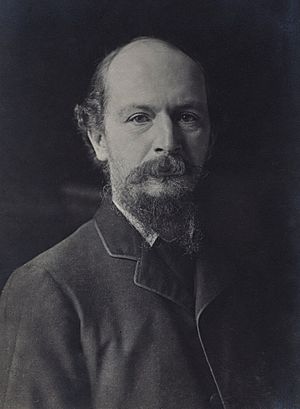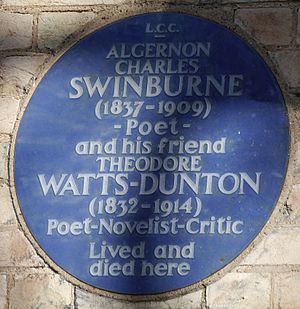Algernon Charles Swinburne facts for kids
Quick facts for kids
Algernon Charles Swinburne
|
|
|---|---|

Swinburne aged 52
|
|
| Born | 5 April 1837 London, England |
| Died | 10 April 1909 (aged 72) London, England |
| Occupation | Poet, playwright, novelist, and critic |
| Education | Eton College |
| Alma mater | Balliol College, Oxford |
| Period | Victorian era |
| Literary movement | Decadent movement, pre-Raphaelite |
| Notable work | Poems and Ballads |
| Signature | |
Algernon Charles Swinburne (5 April 1837 – 10 April 1909) was an English poet, playwright, novelist, and critic. He wrote several novels and collections of poetry such as Poems and Ballads, and contributed to the famous Eleventh Edition of the Encyclopædia Britannica.
His poems have many common motifs, such as the ocean, time, and death. Several historical people are featured in his poems, such as Sappho ("Sapphics"), Anactoria ("Anactoria"), and Catullus ("To Catullus").
Biography

Swinburne was born at 7 Chester Street, Grosvenor Place, London, on 5 April 1837. He was the eldest of six children born to Captain (later Admiral) Charles Henry Swinburne (1797–1877) and Lady Jane Henrietta, daughter of the 3rd Earl of Ashburnham, a wealthy Northumbrian family. He grew up at East Dene in Bonchurch on the Isle of Wight. The Swinburnes also had a London home at Whitehall Gardens, Westminster.
As a child, Swinburne was "nervous" and "frail," but "was also fired with nervous energy and fearlessness to the point of being reckless."
Swinburne attended Eton College (1849–53), where he started writing poetry. At Eton, he won first prizes in French and Italian. He attended Balliol College, Oxford (1856–60) with a brief hiatus when he was rusticated from the university in 1859 for having publicly supported the attempted assassination of Napoleon III by Felice Orsini. He returned in May 1860, though he never received a degree.
Swinburne spent summer holidays at Capheaton Hall in Northumberland, the house of his grandfather, Sir John Swinburne, 6th Baronet (1762–1860), who had a famous library and was president of the Literary and Philosophical Society in Newcastle upon Tyne. Swinburne considered Northumberland to be his native county, an emotion reflected in poems like the intensely patriotic "Northumberland", "Grace Darling" and others. He enjoyed riding his pony across the moors, he was a daring horseman, "through honeyed leagues of the northland border", as he called the Scottish border in his Recollections.
In the period 1857–60, Swinburne became a member of Lady Trevelyan's intellectual circle at Wallington Hall.
After his grandfather's death in 1860 he stayed with William Bell Scott in Newcastle. In 1861, Swinburne visited Menton on the French Riviera, staying at the Villa Laurenti. From Menton, Swinburne travelled to Italy, where he journeyed extensively. In December 1862, Swinburne accompanied Scott and his guests, probably including Dante Gabriel Rossetti, on a trip to Tynemouth. Scott writes in his memoirs that, as they walked by the sea, Swinburne declaimed the as yet unpublished "Hymn to Proserpine" and "Laus Veneris" in his lilting intonation, while the waves "were running the whole length of the long level sands towards Cullercoats and sounding like far-off acclamations".

At Oxford, Swinburne met several Pre-Raphaelites, including Dante Gabriel Rossetti. He also met William Morris. After leaving college, he lived in London and started an active writing career, where Rossetti was delighted with his "little Northumbrian friend", probably a reference to Swinburne's diminutive height—he was just five-foot-four.
Swinburne's health suffered, and in 1879 at the age of 42, he was taken into care by his friend, Theodore Watts-Dunton, who looked after him for the rest of his life at The Pines, 11 Putney Hill, Putney. Watts-Dunton took him to the lost town of Dunwich, on the Suffolk coast, on several occasions in the 1870s.
In Watts-Dunton's care Swinburne lost his youthful rebelliousness and developed into a figure of social respectability. It was said of Watts-Dunton that he saved the man and killed the poet. Swinburne died at the Pines on 10 April 1909, at the age of 72, and was buried at St. Boniface Church, Bonchurch on the Isle of Wight.
Work
Swinburne's poetic works include: Atalanta in Calydon (1865), Poems and Ballads (1866), Songs before Sunrise (1871), Poems and Ballads Second Series, (1878) Tristram of Lyonesse (1882), Poems and Ballads Third Series (1889), and the novel Lesbia Brandon (published posthumously in 1952).
Poems and Ballads caused a sensation when it was first published, especially the poems written in homage of Sappho of Lesbos such as "Anactoria" and "Sapphics": Moxon and Co. transferred its publication rights to John Camden Hotten. Other poems in this volume such as "The Leper," "Laus Veneris," and "St Dorothy" evoke a Victorian fascination with the Middle Ages, and are explicitly mediaeval in style, tone and construction. Also featured in this volume are "Hymn to Proserpine", "The Triumph of Time" and "Dolores (Notre-Dame des Sept Douleurs)".
Swinburne wrote in a wide variety of forms, including Sapphic stanzas (comprising 3 hendecasyllabic lines followed by an Adonic):
So the goddess fled from her place, with awful
Sound of feet and thunder of wings around her;
While behind a clamour of singing women
Severed the twilight.
Swinburne devised the poetic form called the roundel, a variation of the French Rondeau form, and some were included in A Century of Roundels dedicated to Christina Rossetti. Swinburne wrote to Edward Burne-Jones in 1883: "I have got a tiny new book of songs or songlets, in one form and all manner of metres ... just coming out, of which Miss Rossetti has accepted the dedication. I hope you and Georgie [his wife Georgiana, one of the MacDonald sisters] will find something to like among a hundred poems of nine lines each, twenty-four of which are about babies or small children". Opinions of these poems vary between those who find them captivating and brilliant, to those who find them merely clever and contrived. One of them, A Baby's Death, was set to music by the English composer Sir Edward Elgar as the song "Roundel: The little eyes that never knew Light". English composer Mary Augusta Wakefield set Swinburne's work May Time in Midwinter to music as well.
Swinburne was influenced by the work of William Shakespeare, Percy Bysshe Shelley, Catullus, William Morris, Dante Gabriel Rossetti, Robert Browning, Alfred Lord Tennyson, and Victor Hugo. Swinburne was popular in England during his life, but his influence has greatly decreased since his death.
After the first Poems and Ballads, Swinburne's later poetry increasingly was devoted to celebrations of republicanism and revolutionary causes, particularly in the volume Songs before Sunrise. "A Song of Italy" is dedicated to Mazzini; "Ode on the Proclamation of the French Republic" is dedicated to Victor Hugo; and "Dirae" is a sonnet sequence of vituperative attacks against those whom Swinburne believed to be enemies of liberty. Erechtheus is the culmination of Swinburne's republican verse.
He did not stop writing love poetry entirely, including his great epic-length poem Tristram of Lyonesse, but its content is much less shocking than those of his earlier love poetry. His versification, and especially his rhyming technique, remain in top form to the end.
Ancestry
| Ancestors of Algernon Charles Swinburne | ||||||||||||||||||||||||||||||||||||||||||||||||||||||||||||||||||||||||||||||||||||||||||||||||||||||||||||||||||||||||||||||||||||||||||||||||||||||||||||||||||||||||||||||||||||||||||||||||||||||||||||||||||||||||||||||||||||||||||||||||||||||||||||||||||||||||||||||||||||||||||||||||||||||||||||||||||||||||||||||||||||||||||||||||||||||||||||||||||||||||||||||||||||||||||||||||||||||||||||||||||||||||||||||||||||||||||||||||||||||||||||||||||||||||||||||||||||||||||||||||||||||||||||||||||||||||||||||||||||||||||||||||||||||||||||||||||||||||||||||||||||||||||||||||||||||||||||||||
|---|---|---|---|---|---|---|---|---|---|---|---|---|---|---|---|---|---|---|---|---|---|---|---|---|---|---|---|---|---|---|---|---|---|---|---|---|---|---|---|---|---|---|---|---|---|---|---|---|---|---|---|---|---|---|---|---|---|---|---|---|---|---|---|---|---|---|---|---|---|---|---|---|---|---|---|---|---|---|---|---|---|---|---|---|---|---|---|---|---|---|---|---|---|---|---|---|---|---|---|---|---|---|---|---|---|---|---|---|---|---|---|---|---|---|---|---|---|---|---|---|---|---|---|---|---|---|---|---|---|---|---|---|---|---|---|---|---|---|---|---|---|---|---|---|---|---|---|---|---|---|---|---|---|---|---|---|---|---|---|---|---|---|---|---|---|---|---|---|---|---|---|---|---|---|---|---|---|---|---|---|---|---|---|---|---|---|---|---|---|---|---|---|---|---|---|---|---|---|---|---|---|---|---|---|---|---|---|---|---|---|---|---|---|---|---|---|---|---|---|---|---|---|---|---|---|---|---|---|---|---|---|---|---|---|---|---|---|---|---|---|---|---|---|---|---|---|---|---|---|---|---|---|---|---|---|---|---|---|---|---|---|---|---|---|---|---|---|---|---|---|---|---|---|---|---|---|---|---|---|---|---|---|---|---|---|---|---|---|---|---|---|---|---|---|---|---|---|---|---|---|---|---|---|---|---|---|---|---|---|---|---|---|---|---|---|---|---|---|---|---|---|---|---|---|---|---|---|---|---|---|---|---|---|---|---|---|---|---|---|---|---|---|---|---|---|---|---|---|---|---|---|---|---|---|---|---|---|---|---|---|---|---|---|---|---|---|---|---|---|---|---|---|---|---|---|---|---|---|---|---|---|---|---|---|---|---|---|---|---|---|---|---|---|---|---|---|---|---|---|---|---|---|---|---|---|---|---|---|---|---|---|---|---|---|---|---|---|---|---|---|---|---|---|---|---|---|---|---|---|---|---|---|---|---|---|---|---|---|---|---|---|---|---|---|---|---|---|---|---|---|---|---|---|---|---|---|---|---|---|---|---|---|---|---|---|---|---|---|---|---|---|---|---|---|---|---|---|---|---|---|---|---|---|---|---|---|---|---|---|---|---|---|---|---|---|---|---|---|---|---|---|---|---|---|---|---|---|---|---|---|---|---|---|---|---|---|---|---|---|---|---|---|---|---|---|---|---|---|---|---|---|---|---|---|---|---|---|---|---|---|---|---|---|---|---|---|---|---|---|---|---|---|---|---|---|---|---|---|---|---|---|---|---|---|---|---|---|---|---|---|---|---|---|---|---|---|---|---|---|---|---|---|---|---|---|---|---|---|---|---|---|---|
|
||||||||||||||||||||||||||||||||||||||||||||||||||||||||||||||||||||||||||||||||||||||||||||||||||||||||||||||||||||||||||||||||||||||||||||||||||||||||||||||||||||||||||||||||||||||||||||||||||||||||||||||||||||||||||||||||||||||||||||||||||||||||||||||||||||||||||||||||||||||||||||||||||||||||||||||||||||||||||||||||||||||||||||||||||||||||||||||||||||||||||||||||||||||||||||||||||||||||||||||||||||||||||||||||||||||||||||||||||||||||||||||||||||||||||||||||||||||||||||||||||||||||||||||||||||||||||||||||||||||||||||||||||||||||||||||||||||||||||||||||||||||||||||||||||||||||||||||||
See also
 In Spanish: Algernon Charles Swinburne para niños
In Spanish: Algernon Charles Swinburne para niños
- Flowers for Algernon also called Charly. Daniel Keyes homage paid to Algernon Charles Swinburne
- Patience, or Bunthorne's Bride (1881), a Gilbert-and-Sullivan opera that satirizes Swinburne and his poetry
- Poems and Ballads
- Decadent movement
- Tristram of Lyonesse







